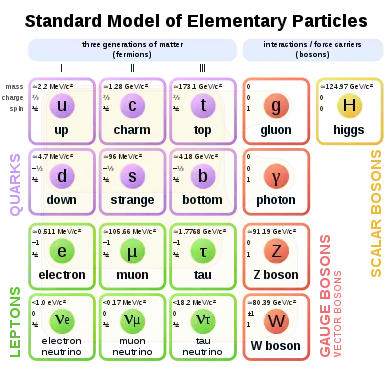Weak hypercharge
In the Standard Model of electroweak interactions of particle physics, the weak hypercharge is a quantum number relating the electric charge and the third component of weak isospin. It is frequently denoted YW and corresponds to the gauge symmetry U(1).[1][2]
| Flavour in particle physics |
|---|
| Flavour quantum numbers |
|
| Related quantum numbers |
|
| Combinations |
|
| Flavour mixing |
It is conserved (only terms that are overall weak-hypercharge neutral are allowed in the Lagrangian). However, one of the interactions is with the Higgs field. Since the Higgs field vacuum expectation value is nonzero, particles interact with this field all the time even in vacuum. This changes their weak hypercharge (and weak isospin T3). Only a specific combination of them, Q = T3 + 1/2 YW (electric charge), is conserved.
Mathematically, weak hypercharge appears similar to the Gell-Mann–Nishijima formula for the hypercharge of strong interactions (which is not conserved in weak interactions and is zero for leptons).
Weak hypercharge was first introduced by Sheldon Lee Glashow in 1961.[3][4][5]
Definition
.svg.png.webp)
Weak hypercharge is the generator of the U(1) component of the electroweak gauge group, SU(2)×U(1) and its associated quantum field B mixes with the W 3 electroweak quantum field to produce the observed
Z
gauge boson and the photon of quantum electrodynamics.
The Weak hypercharge satisfies the relation
where Q is the electric charge (in elementary charge units) and T3 is the third component of weak isospin (the SU(2) component).
Rearranging, the weak hypercharge can be explicitly defined as:
| Fermion family |
Left-chiral fermions | Right-chiral fermions | ||||||
|---|---|---|---|---|---|---|---|---|
| Electric charge Q |
Weak isospin T3 |
Weak hyper- charge YW |
Electric charge Q |
Weak isospin T3 |
Weak hyper- charge YW | |||
| Leptons | ν e, ν μ, ν τ |
0 | +1/2 | −1 | No interaction, if existent | 0 | ||
e− , μ− , τ− |
−1 | −1/2 | −1 | e− R, μ− R, τ− R |
−1 | 0 | −2 | |
| Quarks | u , c , t |
+2/3 | +1/2 | +1/3 | u R, c R, t R |
+2/3 | 0 | +4/3 |
| d, s, b | −1/3 | −1/2 | +1/3 | d R, s R, b R |
−1/3 | 0 | −2/3 | |
where "left"- and "right"-handed here are left and right chirality, respectively (distinct from helicity).
| Mediated interaction |
Boson | Electric charge Q |
Weak isospin T3 |
Weak hypercharge YW |
|---|---|---|---|---|
| Weak | W± |
±1 | ±1 | 0 |
Z0 |
0 | 0 | 0 | |
| Electromagnetic | γ |
0 | 0 | 0 |
| Higgs | H0 |
0 | −1/2 | +1 |

The sum of −isospin and +charge is zero for each of the gauge bosons; consequently, all the electroweak gauge bosons have .
Hypercharge assignments in the Standard Model are determined up to a twofold ambiguity by requiring cancellation of all anomalies.
- Alternative scale
For convenience, weak hypercharge is often represented at half-scale, so that
which is equal to just the average electric charge of the particles in the isospin multiplet.[6]
Baryon and lepton number
Weak hypercharge is related to baryon number minus lepton number via:
where X is a conserved quantum number in GUT. Since weak hypercharge is always conserved this implies that baryon number minus lepton number is also always conserved, within the Standard Model and most extensions.
Neutron decay
Hence neutron decay conserves baryon number B and lepton number L separately, so also the difference B − L is conserved.
Proton decay
Proton decay is a prediction of many grand unification theories.
Hence proton decay conserves B − L, even though it violates both lepton number and baryon number conservation.
See also
- Standard Model (mathematical formulation)
References
- J. F. Donoghue; E. Golowich; B. R. Holstein (1994). Dynamics of the standard model. Cambridge University Press. pp. 52. ISBN 0-521-47652-6.
- T. P. Cheng; L. F. Li (2006). Gauge theory of elementary particle physics. Oxford University Press. ISBN 0-19-851961-3.
- Glashow, Sheldon L. (February 1961). "Partial-symmetries of weak interactions". Nuclear Physics. 22 (4): 579–588. doi:10.1016/0029-5582(61)90469-2.
- Hoddeson, Lillian; Brown, Laurie; Riordan, Michael; Dresden, Max, eds. (1997-11-13). The Rise of the Standard Model: A History of Particle Physics from 1964 to 1979 (1 ed.). Cambridge University Press. p. 14. doi:10.1017/cbo9780511471094. ISBN 978-0-521-57082-4.
- Quigg, Chris (2015-10-19). "Electroweak Symmetry Breaking in Historical Perspective". Annual Review of Nuclear and Particle Science. 65 (1): 25–42. doi:10.1146/annurev-nucl-102313-025537. ISSN 0163-8998.
- Peskin, Michael E. & Schroeder, Daniel V. (1995). An Introduction to Quantum Field Theory. Addison-Wesley Publishing Company. ISBN 978-0-201-50397-5.CS1 maint: uses authors parameter (link) ; Anderson, M. R. (2003). The mathematical theory of cosmic strings. CRC Press. p. 12. ISBN 0-7503-0160-0.

